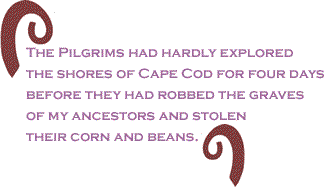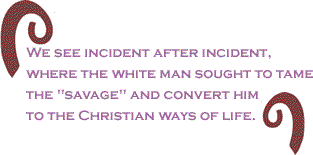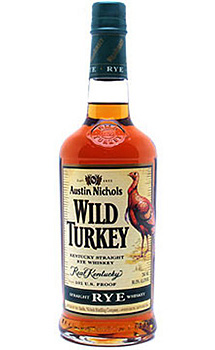
Happy Thanksgiving From Those Who Made It Possible
LIKE Squanto, for instance:
Many of the Indians were looked down upon by the whites, but some Indians helped the whites survive. Squanto was one of those Indians. He helped the Pilgrims survive in the New World, through his compassion and good witted spirit.
Squanto was born somewhere in New England in the late 1500s. He was a member of the Patuxet tribe, and spent some time with the Wampanoag tribe.

He spent three years in New England working as a servant for John Slanie. Squanto still wanting a way home asked Slanie to help. Slanie found a ship captain who was making a voyage to the New World. It was 1619, when Squanto arrived back in North America. Squanto acted as an interpreter in the dealings between the Indians and the captain of the ship. He was finally allowed to begin his journey home. Squanto was away from the Patuxet tribe for 10-12 years.
When Squanto went to where his village used to be, his family was nowhere to be found. He later learned that a great sickness had struck his people, and everyone had died. He was the last of the Patuxet tribe. He was invited to live with the Wampanoag tribe. The chief of this tribe was Massoit. Squanto lived with the Wampanoag tribe until he heard that the white men were building a city nearby. The year was 1620 when the Pilgrims arrived. It was not until December when the Pilgrims decided to settle at Plymouth. The Pilgrims had no idea that the Patuxet tribe once flourished there.
In March Massasoit thought that it was time to meet the Pilgrims. So Massasoit and Squanto arranged for a meeting between the Pilgrims and themselves. The meeting lead to a treaty that was a sign of mutual peace, friendship, and would also become a military alliance. This meant that if one of them was getting attacked the other would come to their aid. The treaty was in effect for over 50 years. None of the Pilgrims ever got hurt or was even attacked by an Indian. When the Indians left from the meeting, Squanto decided to stay and live with the Pilgrims.
Squanto taught the Pilgrims how to farm. He taught them how to plant Indian corn and other vegetables. He also taught the women how to cook the corn. Squanto helped Pilgrims to make friends with other Indian tribes. He was such a great help, William Bradford declared him a special instrument sent from God to help them survive.
Squanto stayed with the Pilgrims for 18 months. When he returned to his tribe he challenged Massasoit for leadership of the tribe. He did not win, and all it did was make most members angry with him. After the election he was considered to be an enemy of the Wampanoag tribe. Squanto died of a fever in 1622, but is still remembered today as a key figure in American folklore. He is a symbol of Thanksgiving. If Squanto had not been there to help the Pilgrims, it could be possible that none of them would have survived. [Mr. Ed: And a lot of Native Americans are saying, "Fuck You, Squanto," today as they rake in the White man's money at their gaming casinos--it's Thanksgiving Special time at all the Native American casinos.]From: www.east-buc.k12.ia.us/01_02/AH/sq/sq.htm
--------------------------------------------------------------------------------------------------------
And Here's the Respectful Native American Look at the White Man's Holy Day
NCAI president issues statement for Thanksgiving
Wednesday, November 25, 2009
Filed Under: National
National Congress of American Indians President Jefferson Keel released the following statement on the eve of Thanksgiving Day. Indian Country was here at the beginning of our first national holiday, and we are still here four centuries later -- grateful that we stand proud of our tribal cultures and contribute their strength to the sustaining diversity of America. Indian Country is grateful on many, many counts. A President and his Administration have heard our concerns and priorities, acknowledging the nation-to-nation relationship, at the first annual White House Tribal Nations Conference. The Embassy of Tribal Nations has opened its doors in the nation's capital. Congress is working in partnership with us to advance the priorities of Indian Country as seldom before. And a national museum on the Washington Mall bears witness to us for all who visit it. We also have much to contribute to this great nation. Above all, our cultural heritage has positioned us to spearhead the historic task of restoring a human connection to the land, air, water, all living things and one another. We give thanks that the Creator has safeguarded our message of oneness in the web of life, for it is instrumental to restoring the global environment and good will among nations. We must give thanks for other safeguards -- the warriors who guard our homeland, many of them far from home on this holiday of gratitude and reunion. Native men and women have steadfastly fought and died defending this country as the highest serving minority group in the U.S. armed forces. We give thanks for all who defend our country. Also this year, we give thanks for the harvest that inspired the first Thanksgiving. Abundant as the harvest has been this year for many, for many others it is a lean year. We've known that unemployment is high and that household hunger is a growing concern. As always, Americans give thanks this day for their individual and community harvest. But especially this year, NCAI calls on them to join the many tribes and individuals in Indian Country who are going the extra mile to help their needy neighbors, just as they did on that first Thanksgiving.
From: 64.38.12.138/News/
--------------------------------------------------------------------------------------------------------
Or You Could Look At It This Way:
Why Some Natives Don’t Celebrate Thanksgiving
The National Day of Mourning kicked off in 1970 quite unintentionally. That year, a banquet was held by the Commonwealth of Massachusetts to celebrate the 350th anniversary of the Pilgrims’ arrival, according to UAINE. The organizers invited Frank James, a Wampanoag man, to speak at the banquet. Upon reviewing James’ speech—which mentioned European settlers looting the graves of the Wampanoag, taking their wheat and bean supplies and selling them as slaves—banquet organizers gave him another speech to recite. Only, this speech left out the gritty details of the first Thanksgiving, according to UAINE.
Rather than deliver a speech that left out the facts, James and his supporters gathered at Plymouth. There, they observed the first National Day of Mourning. Since then, UAINE has returned to Plymouth each Thanksgiving to protest how the holiday’s been mythologized.
In addition to the misinformation the Thanksgiving holiday has spread about Natives and Pilgrims, some indigenous peoples don’t recognize it because they give thanks year-round. During Thanksgiving 2008, Bobbi Webster of the Oneida Nation told the Wisconsin State Journal that the Oneida have 13 ongoing ceremonies of thanksgiving throughout the year.
Anne Thundercloud of the Ho-Chunk Nation told the journal that her people also give thanks on a continual basis. Accordingly, marking one day of the year to do so clashes with Ho-Chunk tradition to a degree.
“We’re a very spiritual people who are always giving thanks,” she explained. “The concept of setting aside one day for giving thanks doesn’t fit. We think of every day as Thanksgiving.”
Rather than singling out the fourth Thursday of November as a day to give thanks, Thundercloud and her family have incorporated it into the other holidays observed by the Ho-Chunk, the journal reports. They extend Thanksgiving observance until Friday, when they celebrate Ho-Chunk Day, a large gathering for their community.
Wrapping Up
Will you celebrate Thanksgiving this year? If so, ask yourself just what you’re celebrating—family, food, football? Whether you choose to rejoice or mourn on Thanksgiving, initiate discussions about the holiday’s origins by not just focusing on the Pilgrims’ point of view but also on what the day meant for the Wampanoag and what it continues to signify for American Indians today.From: racerelations.about.com/od/historyofracerelations/a/ShouldYouCelebrateThanksgiving_2.htm
-------------------------------------------------------------------------------
A Little Native American Truth About Thanksgiving


When Frank James (1923 - February 20, 2001), known to the Wampanoag people as Wampsutta, was invited to speak by the Commonwealth of Massachusettsat the 1970 annual Thanksgiving feast at Plymouth. When the text of Mr. James’ speech, a powerful statement of anger at the history of oppression of the Native people of America, became known before the event, the Commonwealth "disinvited" him. Wampsutta was not prepared to have his speech revised by the Pilgrims. He left the dinner and the ceremonies and went to the hill near the statue of the Massasoit, who as the leader of the Wampanoags when the Pilgrims landed in their territory. There overlooking Plymouth Harbor, he looked at the replica of the Mayflower. It was there that he gave his speech that was to be given to the Pilgrims and their guests. There eight or ten Indians and their supporters listened in indignation as Frank talked of the takeover of the Wampanoag tradition, culture, religion, and land.
That silencing of a strong and honest Native voice led to the convening of the National Day of Mourning. The following is the text of 1970 speech by Wampsutta, an Aquinnah Wampanoag elder and Native American activist.
I speak to you as a man -- a Wampanoag Man. I am a proud man, proud of my ancestry, my accomplishments won by a strict parental direction ("You must succeed - your face is a different color in this small Cape Cod community!"). I am a product of poverty and discrimination from these two social and economic diseases. I, and my brothers and sisters, have painfully overcome, and to some extent we have earned the respect of our community. We are Indians first - but we are termed "good citizens." Sometimes we are arrogant but only because society has pressured us to be so.
It is with mixed emotion that I stand here to share my thoughts. This is a time of celebration for you - celebrating an anniversary of a beginning for the white man in America. A time of looking back, of reflection. It is with a heavy heart that I look back upon what happened to my People.
Even before the Pilgrims landed it was common practice for explorers to capture Indians, take them to Europe and sell them as slaves for 220 shillings apiece. The Pilgrims had hardly explored the shores of Cape Cod for four days before they had robbed the graves of my ancestors and stolen their corn and beans. Mourt's Relation describes a searching party of sixteen men. Mourt goes on to say that this party took as much of the Indians' winter provisions as they were able to carry.

Massasoit, the great Sachem of the Wampanoag, knew these facts, yet he and his People welcomed and befriended the settlers of the Plymouth Plantation. Perhaps he did this because his Tribe had been depleted by an epidemic. Or his knowledge of the harsh oncoming winter was the reason for his peaceful acceptance of these acts. This action by Massasoit was perhaps our biggest mistake. We, the Wampanoag, welcomed you, the white man, with open arms, little knowing that it was the beginning of the end; that before 50 years were to pass, the Wampanoag would no longer be a free people.
What happened in those short 50 years? What has happened in the last 300 years? History gives us facts and there were atrocities; there were broken promises - and most of these centered around land ownership. Among ourselves we understood that there were boundaries, but never before had we had to deal with fences and stone walls. But the white man had a need to prove his worth by the amount of land that he owned. Only ten years later, when the Puritans came, they treated the Wampanoag with even less kindness in converting the souls of the so-called "savages." Although the Puritans were harsh to members of their own society, the Indian was pressed between stone slabs and hanged as quickly as any other "witch."
To read the rest: www.blackcommentator.com/207/207_day_of_mourning_wampsutta.htmlComment from frequent commenter Horatio Parker:
"AFAIK Massasoit made a deal with the Pilgrims because disease had decimated his people but left their enemies, the Narragansett, intact.
So it was a deal with the devil.
If the Pilgrims had landed a few years before, the Indians wouldn't have allowed them to stay. And the stored corn from deserted Indian villages enabled them to survive. Champlain explored Cape Cod a generation or so before, but decided it was too thickly settled. Viral meningitis they think it was..."
----------------------------------------------------------
Thanksgiving in New York City
The streets are empty. Hot damn. The city is boneyard quite. There is a fog over Manhattan. In the fog the skyline looks ghostly. There is nothing open except the certain places that are always open. I am alone. I don't mind. Every Thanksgiving I do the same thing; the same thing I've done for the past 27 years--I go up to my favorite Irish Pub and I have Thanksgiving dinner with the kitchen staff and their families. The chef cooks a big bird up and has stuffing and cranberry sauce and sweet potatoes and pumpkin pie with twin peaks of vanilla ice cream topping it. Most of the folk I'll be gobbling down the gobbler with today speak Spanish. Three are from Peru; one is from El Salvador; several are from Mexico. I'll leave there with full belly, a little wobbly from the cervezas, my face tired from eating and smiling a lot and laughing a lot and having a fine old time with good workingclass people.
When I eat at my fav Irish pub, which is just about every day, my table is back where the staff hangs out. Though I eat in restaurants every day, most people who eat in restaurants I want nothing to do with. Restaurants crowds here in New York City can be overboistrous, irritating you with loud cell phone conversations, pestering you with stupid questions, or coughing up loogies or sneezing without putting their hands in front of their mouths, or constantly staring at me. You see, I'm the kind of character people stare at in restaurants.
The Macy's Day Parade is about to begin. It ends just up the street from me. This year for the first year in its history it's taking a new route. It will still start on West 79th and come downtown down Central Park West onto Broadway. Before our Mall-mad Mayor redesigned Times Square and pretty much turned the stretch of Broadway from Times Square down to in front of Macy's into a pedestrian mall, the parade could traverse straight down Broadway to end in front of the store. Not how however; because now the main artery of uptown traffic files right in front of Macy's, so the parade will have to break off Broadway at one point and come down Sixth Avenue and then turn up 34th to get in front of the department store. The parade this year has turned into a big commercial bullshit parade. They are adding Ronald McDonald as a balloon this year. The balloons are no longer made like the original balloons were made. The Woody Woodpecker balloon used to be the pride of the parade, but now, Woody's buried in some landfill somewhere and the balloons in the parade now are helium filled nylon balloons. Disney will be well represented in these cheap ass balloon characters; plus there'll be plenty of Disney floats promoting their conquest of Broadway theaters. My growls are getting weak. My growls are growing deeper and more cynical.
Happy Thanksgiving. Here, have a shot of turkey on The Daily Growler

thegrowlingwolf
for The Thankful Daily Growler, a Wild Turkey of a Blog!





No comments:
Post a Comment